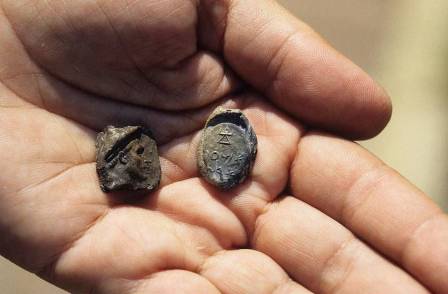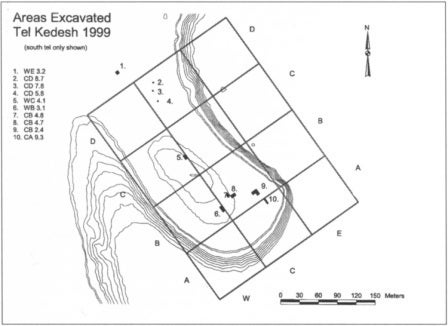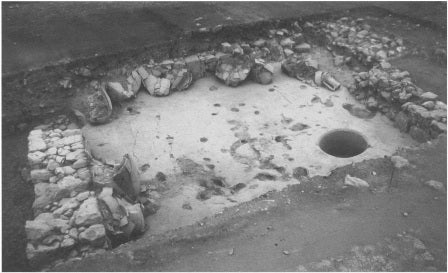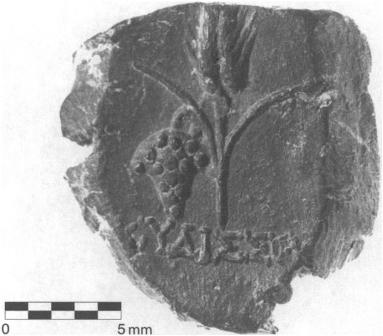1999 was the first full excavation season, intended to be the first of a three-year campaign sponsored by the National Endowment for the Humanities and focusing on Hellenistic and Roman period remains from the lower tel. We were especially interested in investigating the population of this border site in this period and its ties to various groups in the region, including Phoenicians, Jews, Greeks, and Romans.
Almost 50 people joined us between May 24-July 17, 1999 to excavate in ten discrete grid areas of the lower tel. Around 2,300 kg of pottery was recovered from over 204,500 liters of soil, revealing occupation debris from the Persian through modern periods.
We identified a Byzantine mortuary chapel in square WC 4.1, the highest point in the center of the lower tel. The chapel had an apsidal form and mosaic floor, and contained pottery and other artifacts dated to the 4th-6th centuries CE. A series of small (2×2 meter) probes around the saddle between the upper tel and lower tel revealed modern (pre-1948) recycling of ancient materials.
But the lure of the giant building suggested by the magnetometry results from 1998 was too much for us, and we focused most of our efforts around this structure at the southeast edge of the lower tel. Two trenches were set to find the northwestern and southeastern corners of the building, while two other trenches explored the interior of the building space. There is evidence of later Roman and Byzantine activity, but the building itself was a monumental structure that appears to have been abandoned in the mid-2nd century BCE, with items from that period sitting on preserved floors.
One reason we wanted to explore what appeared to be the northwest corner of the building was that there was a dark spot in the magnetometry image covering the area of the corner, which suggested something unique was happening in this area. As excavation progressed, we found a storeroom with huge storage jars in several ceramic fabrics leaning against the walls of the room. Residue analysis of the bottoms of two of these jars indicates that they held grain; therefore, we hypothesized that this room served as a granary for the building complex, possibly holding the wheat collected as taxation from the surrounding areas. A plastered pit in the center of the room, somewhat larger in diameter than the jars, was likely used to hold the jars steady for filling or emptying.
But the most exciting moment came while excavating in the room just to the west of the storage jar room: an undergraduate student who had been working on the sift came up to the directors with a few small objects, no bigger than quarters, in her hand: “Are these something?” she asked. Something indeed!

Bullae found in 1999; on left, an official Seleucid royal portrait, on right, the goddess Tanit with Phoenician inscription
The objects are ancient sealings – also known as bullae – and we found around 1400 during the 1999 season (plus several hundred more in 2000). In the Hellenistic world, government officials and private citizens conducting business would seal documents with pieces of clay stamped with an impression of their personal or official signet ring as a mark of authenticity. We think so many were preserved at Kedesh in a single room on account of the extremely hot fire which occurred after the abandonment of the building in the mid-2nd century BCE (the fire was likely aided by the vast quantities of papyrus in the room). The high temperatures fired the raw clay, preserving them for us to find over two thousand years later. Although private archives are known from the ancient world (for example at Delos and Seleucia), the presence of official seals with Seleucid royal imagery indicates the public and governmental nature of this particular archive. Among the sealings are also numerous images of Greek gods, including Aphrodite, Apollo, and Tyche, Seleucid symbols such as the anchor, and the Phoenician goddess Tanit. A single seal with the inscription ΚΥΔΙΣΣΟΥ (“of Kedesh”) might be the official seal of the Kedesh administrator: the accompanying iconography of a stalk of wheat and cluster of grapes could well represent the agricultural economy of the region, which still produces grain and wine.




